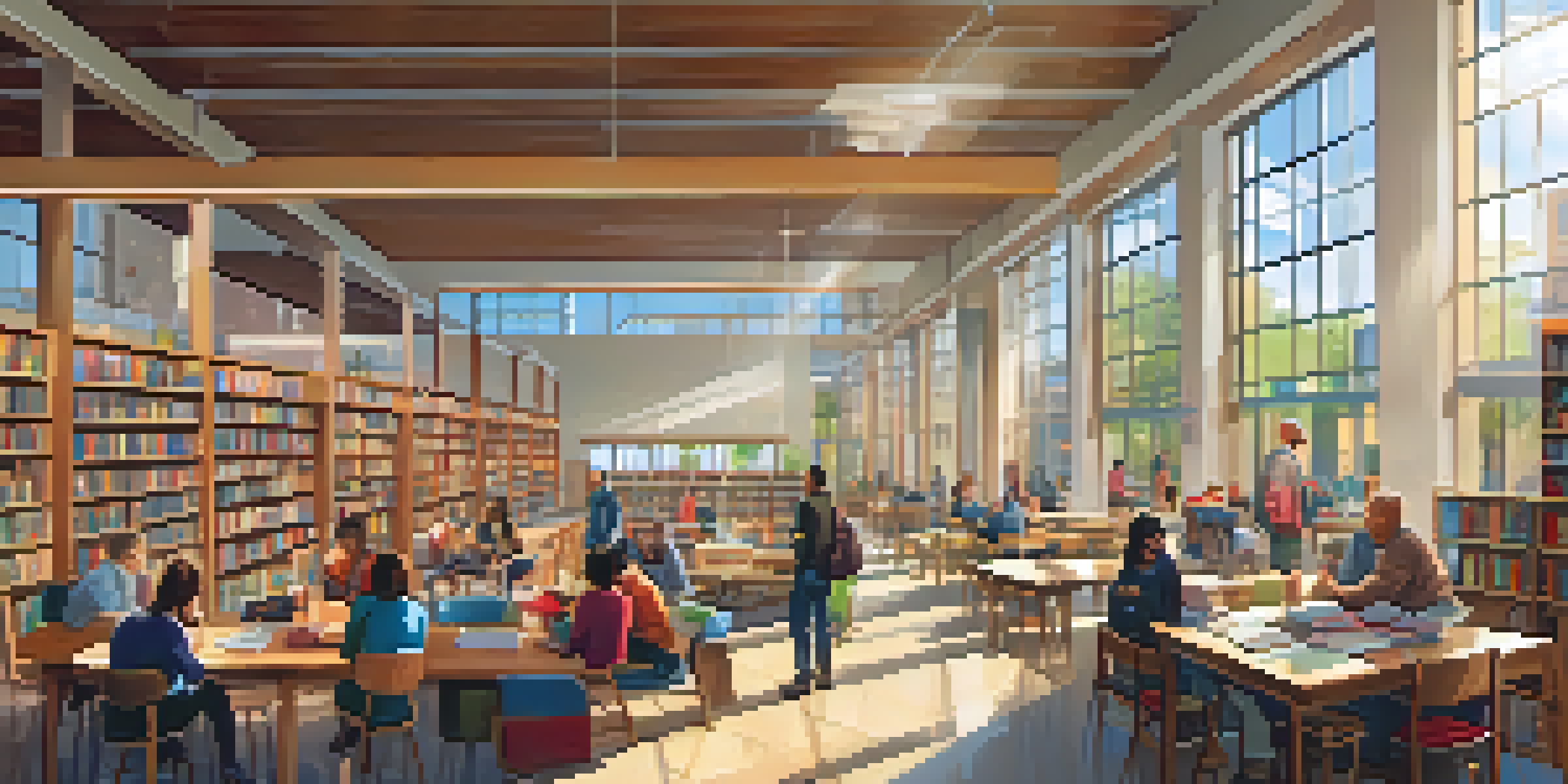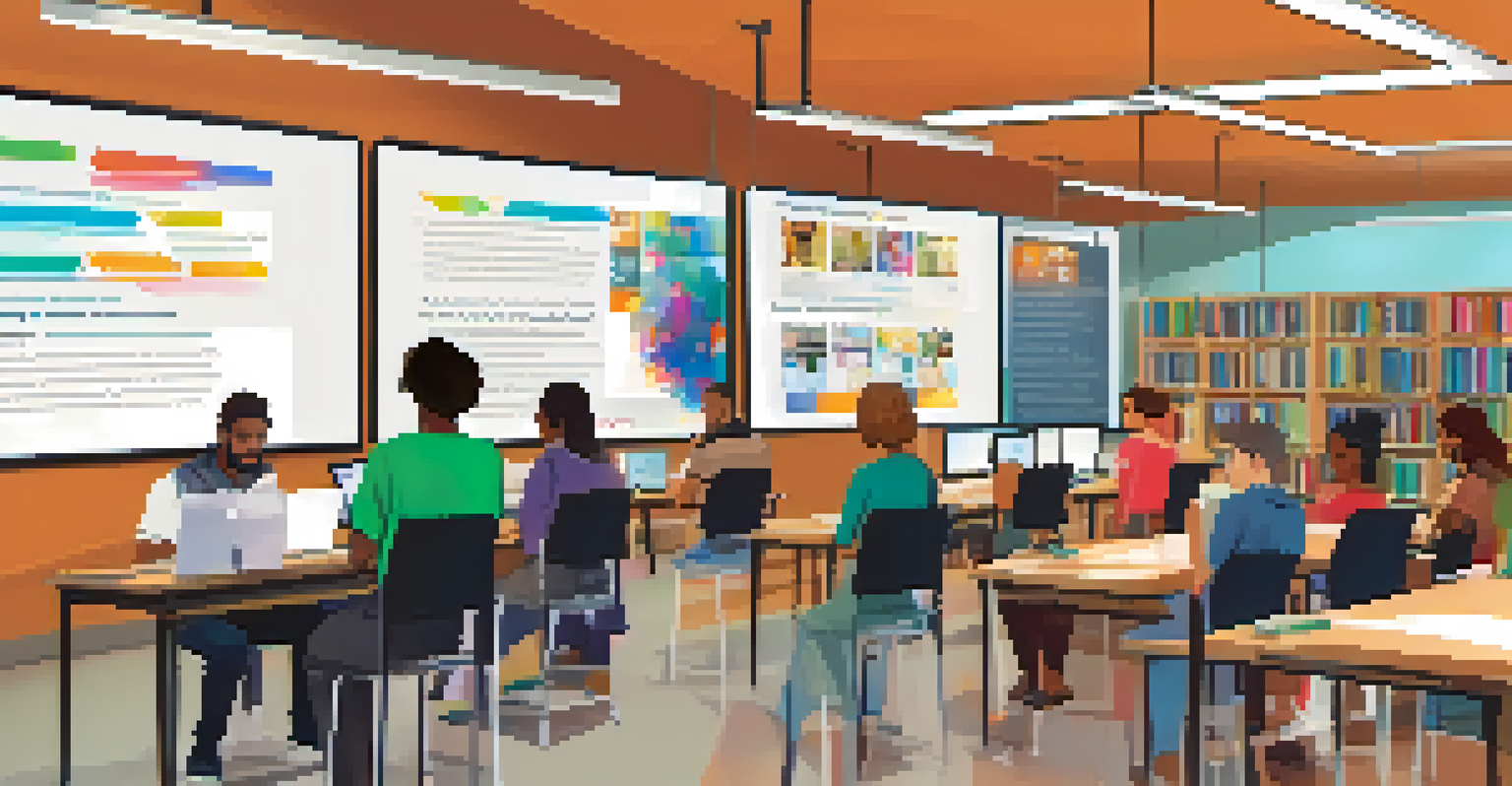Public Libraries: Cultural Hubs in New York City

The Role of Public Libraries in NYC’s Cultural Landscape
Public libraries in New York City are much more than just book repositories; they are vibrant cultural hubs. They play a crucial role in community engagement, offering a space for learning, creativity, and connection. With over 200 branches, these libraries cater to diverse populations, ensuring that everyone has access to resources and programs that reflect their unique cultures.
Public libraries are not just a place to borrow books; they are the heart of the community, bringing people together and nurturing creativity.
From hosting author talks to art exhibitions, public libraries foster a sense of belonging and community spirit. They provide a platform for local artists and authors to share their work, enriching the cultural tapestry of the city. This involvement helps bridge gaps between different communities, inviting residents to explore and appreciate each other's stories.
Moreover, libraries often collaborate with local organizations to offer workshops and events, further enhancing their impact. Whether it’s a film screening or a poetry reading, these activities create opportunities for dialogue and cultural exchange. In essence, public libraries are vital players in nurturing a culturally rich environment within New York City.
Educational Programs: Lifelong Learning Opportunities
One of the standout features of NYC public libraries is their commitment to lifelong learning through various educational programs. Libraries offer a plethora of classes ranging from language lessons to computer skills training, making education accessible to all ages. This dedication to continuous learning helps empower individuals and boost their confidence in navigating the modern world.

For example, imagine a retired teacher learning digital marketing skills to share her passion for education online. This transformative experience is made possible through library programs that cater to diverse interests and needs. By providing such resources, libraries play a pivotal role in fostering personal growth and development.
Libraries as Cultural Hubs
Public libraries in NYC serve as vibrant cultural centers that foster community engagement and celebrate diversity.
Additionally, these educational initiatives often target underserved communities, ensuring that everyone has the chance to succeed. By bridging the educational gap, public libraries contribute to a more informed and engaged citizenry. Ultimately, they are not just places of reading, but spaces of empowerment and opportunity.
Community Events: Bringing People Together
Public libraries host a variety of community events that serve to unite people from different backgrounds. From book clubs to cultural festivals, these gatherings create a sense of camaraderie and shared experience. They offer a welcoming environment where individuals can come together to discuss, learn, and celebrate their differences and similarities.
A library is a place where you can lose yourself and find yourself at the same time.
For instance, consider the annual literary festival held at one of NYC’s libraries, where local authors, poets, and readers gather to celebrate the written word. Events like these not only promote literacy but also foster a love for literature within the community. Such interactions can spark friendships and connections that extend beyond the library walls.
Moreover, these events often include partnerships with local businesses and organizations, further enriching the community fabric. By collaborating with various stakeholders, libraries enhance their offerings and engage a wider audience. This spirit of inclusivity makes public libraries essential gathering spots for cultural exchange and social interaction.
Digital Resources: Accessing Information Anytime, Anywhere
In today’s digital age, public libraries have adapted by offering a wealth of online resources. From e-books to online courses, patrons can access information and learning materials anytime, anywhere. This shift not only caters to tech-savvy individuals but also ensures that everyone has the opportunity to learn and grow, even from the comfort of their own home.
Imagine a student who needs to research a topic late at night; with just a few clicks, she can access an extensive database of articles and e-books through her local library’s website. This convenience removes barriers to information, making learning more accessible than ever. It also underscores the importance of libraries in the digital landscape.
Lifelong Learning Opportunities
NYC public libraries offer a variety of educational programs that empower individuals of all ages to pursue lifelong learning.
Additionally, libraries provide support for using these digital resources, offering tutorials and tech help sessions. This initiative helps bridge the digital divide, ensuring that all community members can benefit from technology. As such, public libraries remain relevant in an increasingly digital world, continuing to serve as critical access points for knowledge.
Cultural Programs: Celebrating Diversity and Heritage
Public libraries in NYC embrace cultural diversity by hosting programs that celebrate various heritages. These events often feature music, dance, and food from different cultures, allowing attendees to experience the richness of global traditions. By highlighting these cultural elements, libraries foster an appreciation for diversity within the community.
For instance, during Hispanic Heritage Month, a library might host workshops on traditional crafts or cooking classes, inviting patrons to immerse themselves in the culture. Such programs not only educate but also create a sense of pride among community members. They bridge cultural gaps and encourage dialogue, helping to build understanding and respect.
In addition, libraries often collaborate with cultural organizations to bring authentic experiences to their patrons. These partnerships ensure that the programs are reflective of the communities they serve, making them more impactful. Ultimately, cultural programs in public libraries enrich the cultural landscape of NYC and strengthen community bonds.
Support for Local Artists: Nurturing Creativity
Public libraries actively support local artists by offering space for exhibitions and performances. This initiative not only provides artists with a platform to showcase their talents but also enriches the library experience for patrons. By engaging with local art, community members can discover new talents and perspectives, fostering a deeper appreciation for the arts.
Imagine visiting a library where a local painter is displaying her work, telling the story behind each piece during a gallery talk. Such experiences create meaningful connections between artists and community members, encouraging dialogue and inspiration. These interactions can spark creativity and motivate others to explore their artistic passions.
Support for Local Artists
Public libraries actively nurture local artists by providing platforms for exhibitions and performances, enriching the cultural landscape.
Furthermore, libraries may offer workshops or residencies for artists, providing them with resources and support to develop their skills. This nurturing environment cultivates a thriving arts community, making libraries vital players in the cultural ecosystem of NYC. Ultimately, by championing local artists, public libraries contribute to a vibrant and diverse cultural landscape.
The Future of Public Libraries as Cultural Centers
As we look to the future, public libraries in New York City are poised to continue evolving as cultural centers. They are embracing new technologies and trends, ensuring they remain relevant in a rapidly changing world. This adaptability is crucial for meeting the needs of diverse communities and fostering cultural engagement.
For example, libraries are increasingly incorporating virtual programming, allowing them to reach wider audiences and connect with people who may not be able to visit in person. This innovation opens up new possibilities for cultural exchange and learning, breaking down geographical barriers. It also reflects the library's commitment to inclusivity and accessibility.

Moreover, as discussions around social justice and equity grow, public libraries are stepping up to address these issues within their communities. By prioritizing marginalized voices and offering resources that promote equity, they are reinforcing their role as essential cultural hubs. In this way, the future of public libraries is bright and filled with potential for continued cultural enrichment.